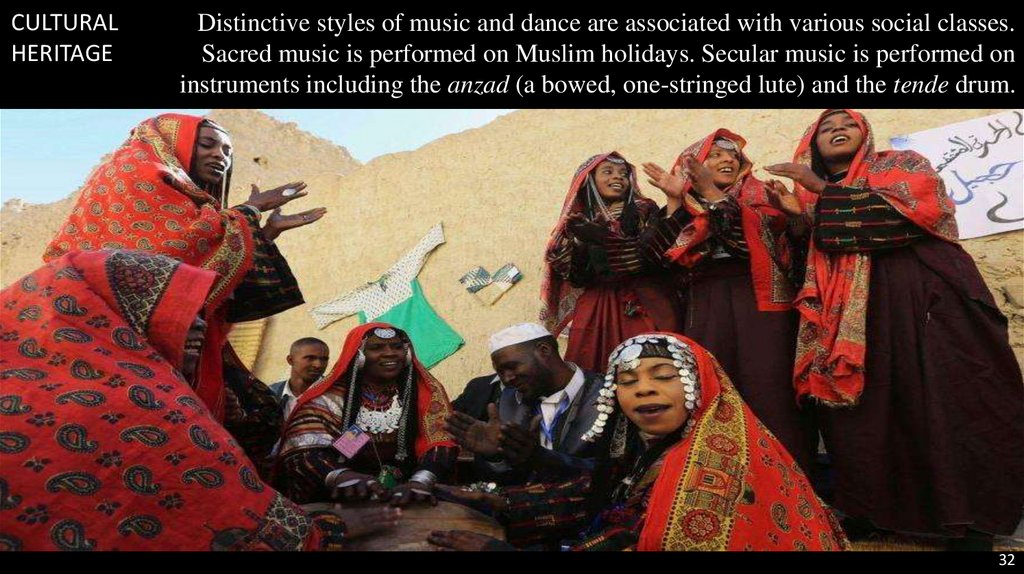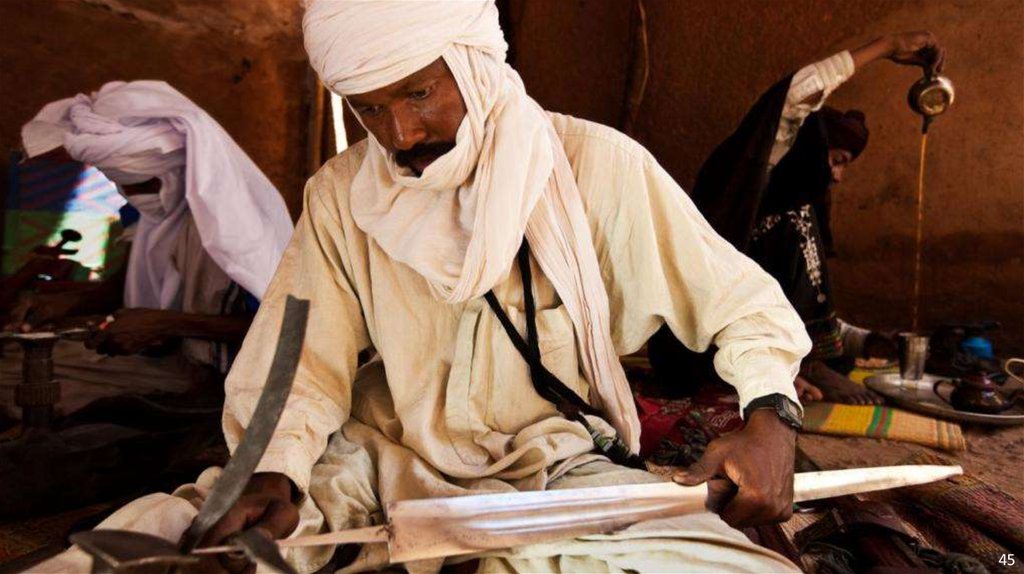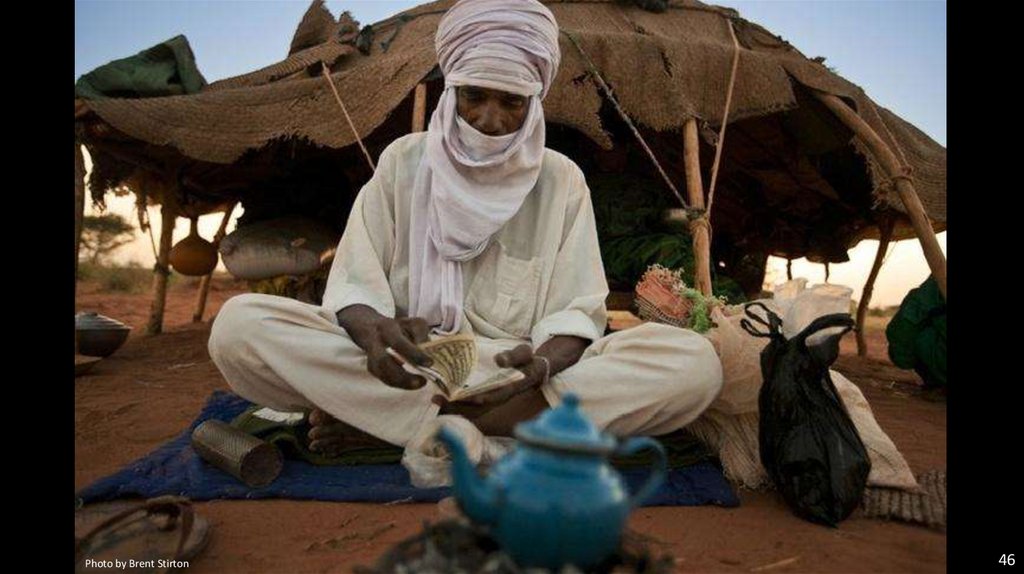Similar presentations:
The Tuareg people
1.
The Tuareg peopleStudents Pungina A., Taphaeva I.
1
2.
The Tuareg: Blue Men of the SaharaThe Tuareg are best known for the
men's practice of veiling their faces
with a blue cloth dyed with indigo.
Early travelers' accounts often referred
to them as the "Blue Men" of the
Sahara Desert, the region where many
Tuareg live. It is believed that the
Tuareg are descendants of the North
African Berbers, and that they
originated in the Fezzan region of
Libya. They later expanded into
regions bordering the Sahara, bringing
local farming peoples into their own
society.
Algeria, Tuareg Cavalryman,1960
PHOTOGRAPH BY ROBERT F. SISSON
2
3.
By the fourteenth century, traderoutes to the wealthy salt, gold,
ivory, and slave markets in North
Africa, Europe, and the Middle
East had sprung up across Tuareg
territory. The Tuareg grew rich as
livestock breeders and traders in the
Saharan and Sahelian regions.
(The Sahel is the region south of
the Sahara Desert that is marked by
times of drought but is not a real
desert)
3
4.
In the late nineteenth century, European exploration and military expeditions led to French ruleof the Tuareg homeland. By the early twentieth century, the French had brought the Tuareg
under their colonial control. They ended Tuareg trade activities, including the collection of
tariffs and the protection services for camel caravans crossing the Sahara.
Traditional way of
transporting salt
Photo by Brent Stirton
4
5.
The Tuareg speak the Tuareg languages (alsoknown as Tamasheq), which belong to the
Berber branch of the Afroasiatic family. About
half this number is accounted for by speakers
of the Eastern dialect (Tamajeq, Tawellemmet).
Photo
Bulter
Photo by
by Henrietta
Esam Omran
Al-Fetori
The Tuareg people are a Berber ethnic
confederation. They principally inhabit the
Sahara in a vast area stretching from far
southwestern Libya to southern Algeria, Niger,
Mali and Burkina Faso.
5
6.
Being nomadic, they move constantlyacross national borders, and small
groups of Tuareg also live in
southeastern Algeria, southwestern
Libya and northern Burkina Faso, and
a small community in northern Nigeria.
6
7.
Most Tuareg are Muslims. But theirtraditional belief system and rituals
overlap with Islam. There is a
widespread belief in spirits. Most
spirits are considered evil and are
believed to cause illnesses. Some
Tuareg perform fortune-telling with
cowrie shells, lizards, mirrors, and the
Koran (the sacred text of Islam).
Unlike women in many other Islamic societies, most Tuareg women do not wear
veils in public. They may also independently inherit property and begin the process
leading to a divorce.
7
8.
Islamic holy men, called marabouts, are believed to possess a special power of blessing, called albaraka. They educate children in verses from the Koran and they officiate at ceremonies marking rites of
passage and Muslim holidays.
The Tuaregs have been
one of the influential
ethnic groups who have
helped spread Islam and
its legacy in North Africa
and the adjacent Sahel
region.
Timbuktu, an important Islamic center famed for its ulama, was established by
Maghsharan Tuareg at the start of the 12th century.
8
9.
A diagram of the Prophet's Mosque in Medina is one of the treasures found amongthousands of ancient manuscripts.
Photo by Brent Stirton
9
10.
Tabaski commemorates the story of Abraham'swillingess to sacrifice his son.
The Tuareg celebrate Ganni (also
called Mouloud ), the Prophet Muhammad's
birthday, with special sacred and secular songs
and camel races.
MAJOR HOLIDAYS
The 19th Ghat Festival in Tripoli , December 2013 In the annual event
Photo by Esam Omran Al-Fetori
10
11.
The 19th Ghat Festival in Libya , December 2013 In theannual event
11
12.
The end of the monthlong Ramadan fast iscelebrated by animal
sacrifice, feasting,
prayer, and evening
dancing festivals.
Secular holidays that the
Tuareg celebrate include
Niger Independence Day
(August 3) and Niger
Republic Day (December
18). On these days, there
are camel races and
feasting in the
countryside, and parades
and speeches in the
towns.
Photo by Brent Stirton
12
13.
RITES OF PASSAGEName day is held one week following a baby's birth. On the evening before
the name day, the older female relatives carry the baby around the mother's
tent. They give him or her a secret name in the Tamacheq language. The
next day, the baby's hair is shaved in order to cut off the baby's ties to the
spirit world. At the mosque, the marabout (Islamic holy man) and the father
give the baby an Arabic name from the Koran. As the marabout pronounces
the baby's official Koranic name, he cuts the throat of a ram. Then there are
feasts, camel races, and evening dancing festivals.
Photo by Brent Stirton
13
14.
Tuareg men begin to wear a veil over the face atapproximately eighteen years of age. This
signifies that they are adults and are ready to
marry.
14
15.
The most famous Tuaregsymbol is the Tagelmust
(also called éghéwed),
referred to as a Cheche
(pronounced "Shesh"), an
often indigo blue-colored
veil called Alasho. The
men's facial covering
originates from the belief
that such action wards off
evil spirits. It may have
related instrumentally
from the need for
protection from the harsh
desert sands.
Photo by Henrietta Bulter
A Tuareg man in a traditional indigo veil, which is likely to leave his face with a blue
mark across his skin.
15
16.
Weddings are very elaborate, lasting for seven days.There are camel races and evening festivals featuring
songs and dances. The groom's family arrives in the
bride's village on gaily decorated camels and
donkeys. Older female relatives of the bride build her
a special tent.
A Tuareg husband and wife wearing
traditional jewellery
16
17.
Burial takes place as soon as possible after aperson has died. It is quickly concluded with a
graveside prayer led by a marabout. Burial is
followed by condolences. Relatives and friends
gather at the home of the dead person, and the
marabout offers a prayer and blessing. The guests
eat a memorial feast.
Photo by Brent Stirton
17
18.
RELATIONSHIPSPhoto by Brent Stirton
Like many other African
societies, the Tuareg have very
elaborate greetings. In the Air
regional dialect, Oy ik? signifies
"How are you?" This is
followed by Mani
eghiwan, meaning "How is your
family?", and additional
greetings such as Mani
echeghel? (How is your work?).
The usual polite response to
these questions is Alkher
ghas, or "In health only."
Exchanging gifts is an
important sign of friendship
between women.
18
19.
The Tuareg in rural areas stillrecognize social categories from the
time before colonization. These are
based on family descent and inherited
occupation.
For example, imajeghen (nobles) refers
to Tuareg of noble birth,
while inaden refers to the smiths and
artisans.
In principle, people are supposed to
marry within their own social category.
However, this practice has been
breaking down for some time,
especially in the towns.
19
20.
FAMILY LIFEIn rural communities, a nuclear family (parents and their children) live in each
tent or compound (living area). Each compound is named for the married
woman who owns the tent. She may make her husband leave the tent if she
divorces him.
Fathers are the disciplinarians of the family. But other men, especially maternal
uncles (uncles on the mother's side), often play and joke with small children.
Grandmothers also have a close, affectionate relationship with the children.
Cousins have a relaxed relationship marked by teasing and joking.
Relationships with in-laws are reserved, distant, and respectful.
20
21.
For a Tuareg man, it is highly shameful to eat in front of hismother-in-law, who commands great respect.
Photo by Henrietta Bulter
21
22.
Traditionally, the Tuareg have married withintheir own social category, preferably to a
close cousin. In the towns, both of these
traditions are breaking down. In rural areas,
they remain strong. However, many
individuals marry close relatives only to
please their mothers. Later they divorce and
marry nonrelatives. Some wealthy Tuareg
men practice polygamy (having more than
one wife at the same time).
Two-thirds of a family's property goes to the
sons as an inheritance; one-third, to the
daughters. A political office usually passes
from father to son.
Women who lack daughters of their own
often adopt nieces to help with the
housework.
Photo by Brent Stirton
22
23.
Women keep the tent and all the possessions whenthey split, including the domestic animals which the
tribe relies on to survive.
Photo by Steve Mccurry
23
24.
It is the men who cover up their faces, while the women arehappy to show off their faces - although they often cover
their hair.
Photo by George Steinmetz
24
25.
CLOTHINGThe veil that Tuareg men wear on their
faces has several meanings. It is, first
of all, a symbol of male identity. It is
also thought to protect the wearer from
evil spirits. In addition, it is
considered an attractive adornment
and can be worn in various styles. The
face veil is worn differently in
different social situations. It is worn
highest (covering the nose and mouth)
to express respect in the presence of
chiefs, older persons, and in-laws. Once they marry, Tuareg women wear a head
scarf that covers their hair. In rural areas, Tuareg
men wear long Islamic robes. Women wear
wraparound skirts and embroidered blouses. In
the towns, clothing is more varied. It includes
West African tie-dyed cottons, and also
fashionable European styles for some wealthier
people.
25
26.
Photo by Brent StirtonPhoto by Frans Lemmens
26
27.
Photo by Frans Lemmens27
28.
A female murzuq band member wears atraditional costume of highly coloured
clothing and a headpiece adorned with
buttons and shells.
Photo by Esam Omran Al-Fetori
28
29.
FOODAlmost 95 percent of the daily
diet in rural areas consists of
grains. Protein is added by
dairy products (milk and
cheese). Fruits such as dates
and melon are eaten in season.
Dried and pounded vegetables
are added to sauces. Meat is
eaten primarily on holidays
and at rites of passage.
Photo by Brent Stirton
29
30.
EDUCATIONUntil recently, many Tuareg
resisted sending their children
to secular (nonreligious)
schools because they did not
like or trust the government.
Nowadays, however, more
Tuareg recognize the
importance of formal
education.
Photo by Brent Stirton
30
31.
Most rural residents finish atleast primary school. Some
continue on to junior and senior
high schools in the towns. Very
few Tuareg attend universities.
Koranic (Islamic) schools are
important and respected among
the Tuareg.
Photo by Brent Stirton
31
32.
CULTURALHERITAGE
Distinctive styles of music and dance are associated with various social classes.
Sacred music is performed on Muslim holidays. Secular music is performed on
instruments including the anzad (a bowed, one-stringed lute) and the tende drum.
32
33.
In the countryside, most everydayoccupations involve hard physical labor.
The Western concept of "exercise" as a
separate category does not exist
Photo by Brent Stirton
33
34.
In the towns, there are organized athletics at schools, includingsoccer and racing. There is also traditional wrestling
34
35.
In the countryside, most residents providetheir own entertainment. Children make
their own dolls and other toys. Adults
dance, sing, and play musical instruments
at festivals. In addition, people of all ages
play board games with stones and date
pits.
Photo by Brent Stirton
35
36.
Most camel herding and all caravan trade arestill done by men. Men plant and irrigate
gardens, and women harvest the crops.
The camels are of vital importance in the Sahara, and are often the only thing a man is left with
when he gets divorced.
36
37.
Because of natural disasters and political tensions, it is difficult to make a livingonly from nomadic herding.
Photo by Brent Stirton
37
38.
Most rural Tuareg today combine differentoccupations, including herding, oasis
gardening, caravan trading, and migrant labor.
Photo by Brent Stirton
38
39.
Photo by Brent Stirton39
40.
The Tuareg have travelled across the Sahara for more than 1,000 years, the camels leading the wayto fresh pastures.
Photo by Brent Stirton
40
41.
Photo by Brent Stirton41
42.
Others produce arts and crafts for the touristtrade or work as security guards in the towns.
Photo by Brent Stirton
42
43.
In thetowns, a
few
Tuareg
have
become
businessm
en or
teachers.
Photo by Brent Stirton
43
44.
Tuareg crafts consist mainly of metalworking (silver jewelry), leatherworking (boxes and saddles for camels), and woodworking (delicately
decorated spoons and ladles)
Photo by Brent Stirton
44
45.
4546.
Photo by Brent Stirton46
47.
SOCIAL PROBLEMSDevelopment programs from the 1940s into the 1970s
failed to help the Tuareg because the programs
worked against their traditional herding patterns.
Between 1991 and 1995, Tuareg who had received
military training and arms in Libya carried out a
separatist rebellion. They demanded the right to rule
their own region. Since that time, there has been
continued off-and-on fighting in some regions of Mali
and Niger. Some of the Tuareg have been forced into
refugee camps.
Photo by Brent Stirton
47
48.
THE ENDPhoto by Brent Stirton
All photos were taken from Daily Mail, National Ggeographic,Trip Down Memory Lane…..Internet,ect.
48
49.
BIBLIOGRAPHY• Clarke, Thurston. The Last Caravan. New York: Putnam, 1977
• Nicolaisen, Johannes, and Ida Nicolaisen. The Pastoral Tuareg: Ecology, Culture
and Society. New York: Thames and Hudson, 1997
• Rochegude, Anne. Tarlift, Tuareg Boy: My Village in the Sahara. Translated and
adapted by Bridget Daly. Morristown, N.J.: Silver Burdett, 1985
WEBSITES
• World Travel Guide. Niger. http://www.wtgonline.com/country/ne/gen.html ,
1998
• Wikipedia contributors. Tuareg people. In Wikipedia, The Free Encyclopedia.
https://en.wikipedia.org/w/index.php?title=Tuareg_people&oldid=929843499,
2019
• Центр Льва Гумилева. Туареги. https://www.gumilev-center.ru/tuaregi/, 2011
49

















































 history
history culturology
culturology








